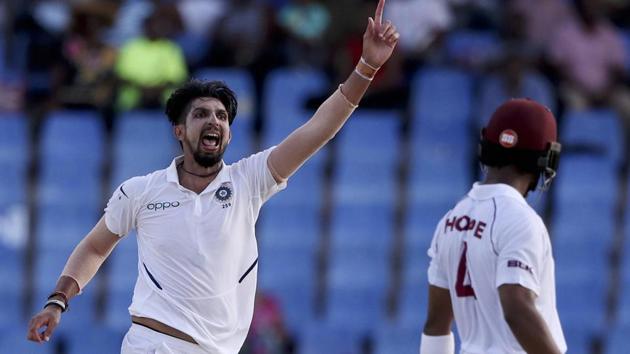India vs West Indies: ‘Bumrah classy but Ishant is the leader’
Ishant Sharma is using his height and consistency of line and length to great effect, says Windies legend Andy Roberts
Few fast bowlers have been as gifted as Ishant Sharma. He is blessed with an athletic frame, an imposing height, an explosive and rhythmic run-up that ends with a copy-book release. His international entry was dazzling too, with a five-wicket haul against Pakistan in Bengaluru in his second Test, in Dec, 2007, and a sizzling spell to Ricky Ponting at Perth the following month.

Yet, Sharma took a long time to realise his potential as bowling on docile subcontinent tracks remained a struggle. But something clicked during his 2017-18 season with Delhi and the county stint with Sussex after that. That has reflected in his bowling as Sharma has hit the good length regularly with swing, and, has been a transformed player ever since.
It’s no more about looking to blast the batsmen out with pace but letting the ball do the talking. It was on display in the first Test in Antigua as well, when Ishant pitched the ball up allowing for late movement, to return with an eight-wicket match haul. Despite his struggles in the subcontinent, Sharma remained effective overseas in helpful conditions.
Also Read: India T20I squad for South Africa series - No place for MS Dhoni, Hardik returns
The numbers speak for themselves. As India go into the Jamaica Test on Friday, leading the two-match Test series 1-0, all eyes will be on him. If India win this Test, India sweep the series 2-0 and Virat Kohli will overtake MS Dhoni as the most successful India skipper in terms of number of wins. Both have led India to 27 wins each. Sharma, set to play his 92nd Test, is also on the brink of a coveted record. He is one wicket shy of becoming India’s most successful pace bowler outside Asia, overtaking Kapil Dev’s tally of 155. The impressive part is that when compared with the greatest India pace bowler, Sharma has taken the same number of games to get to that tally—45 Tests.
LEADER OF THE ATTACK
For all the early and sustained success of Jasprit Bumrah, fast bowling legend Andy Roberts thinks Ishant is the leader of this Indian pace attack. “In Test matches, Ishant Sharma has shown that he is the leader of the pack. Although, Jasprit Bumrah because of his uniqueness is making the most of the spotlight,” said Roberts over phone from Antigua. “Whenever India is in trouble and they need wickets, they revert to Ishant Sharma. That is what a leader is all about. He uses his gift of height a lot. He is no longer 19, he is approaching his 30s, and bowls very consistent line and length.”
The experience Sharma has earned over the years, playing at the highest level for nearly 12 years now, adds an extra edge to his abilities in terms of situational awareness and conditional understanding. It’s not been an easy ride for him, and the struggles have also contributed to the maturity to understand the various challenges of fast bowling.
Also Read: Why India got 60 points and England and Australia only 24 for their wins in World Test Championship
Sir Viv Richards had said during an experts panel discussion during the first Test on how the West Indies pace battery of the 1970s used to lean on Roberts for advice and seek inspiration. The Antiguan took 202 wickets in 47 Tests (nine 5-wkt hauls and two 10-wkt hauls), and left a lasting legacy. Ishant also has nine five-wicket hauls and one 10-for, but in 91 Tests.
GOOD BUT NOT GREAT
The West Indies pace quartet used to operate at a different level as they had instilled fear in batsmen with their intimidating pace. But the Antiguan legend doesn’t hesitate in calling India’s current bowling attack as ‘good’. It’s a huge compliment from a man who sets high standards for fast bowling.
Sharma, Bumrah and Mohammed Shami are a good combination, he said. Bumrah took a five-wicket haul in the second innings at Antigua and Shami struck double blows in both innings. “They work well, complement each other. They are a good combination but I won’t classify them as great at the moment. They bowl consistent line and length but not that quick. It’s a steady pace attack. The problem is that in the West Indies team there is no batsman who is prepared to stand up and fight.”
Also Read: Kohli on the cusp of breaking Indian cricket’s biggest record
While it is impossible to match the firepower of the West Indies pace attack of the 1960s to the 1990s, from Wes Hall to Curtly Ambrose, there’s no doubt for the first time in their cricket history do India have an incisive pace attack with consistent success home and away. What they lack in pace, they more than make up with skill. If Sharma has movement and bounce, Bumrah’s freakish action makes him difficult to read. Shami on the other hand, extracts sharp pace with a beautiful seam position.
“Bumrah is in a class (of his own). He is very deceptive, very difficult to handle because of his unique style,” said Roberts. The legend has some words of advice for Shami though. “I liked Shami from the first time I saw him. I like his approach but he needs to look at his run-up again because he is not getting the maximum out of it as he slows down towards the end of it. If he can make more out of the final four strides he will be a lot more difficult to handle. He slows up when he should be at his most explosive but that is when he is tapering down.”
CAPTAIN’S ROLE
Equally crucial in the success of any attack is its handling. Initially, even captain Kohli didn’t seem to be aware that it was controlled aggression which worked best for Sharma, as the skipper on occasions seemed to goad him to be extra aggressive. An example was the unnecessary confrontations Sharma was involved in with Sri Lanka bowler, Dhammika Parsad, in the 2015 away series.
It not only made for ugly cricket, but resulted in Sharma being banned for a Test in the next series against South Africa when he was in good rhythm. He displayed excellent form in Sri Lanka as India won the second and third Tests in Colombo to clinch the three-match series 2-1, but the Delhi pacer’s performance was punctured by frequent confrontations with the Sri Lankan players.
However, from what Roberts saw at Antigua, Kohli sure knows how to get the best out of his boys and is patient enough with them. “Virat is doing a good job. He keeps them fresh. The fast bowlers don’t have to bowl that much because he has a spinner who can come in and tie up one end so it allows the fast bowlers to operate in short spells.”






